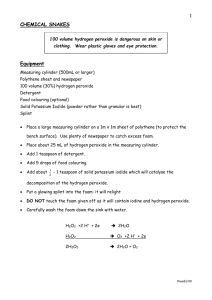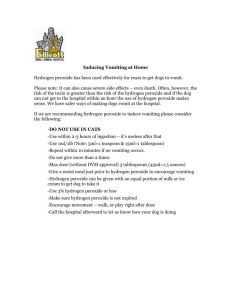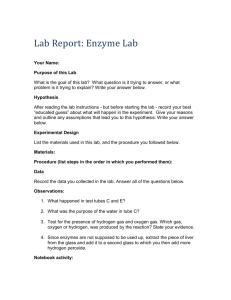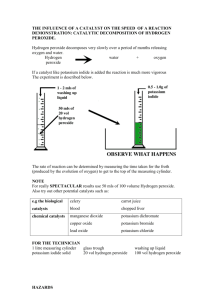Chemical Summary for Hydrogen Peroxide
advertisement
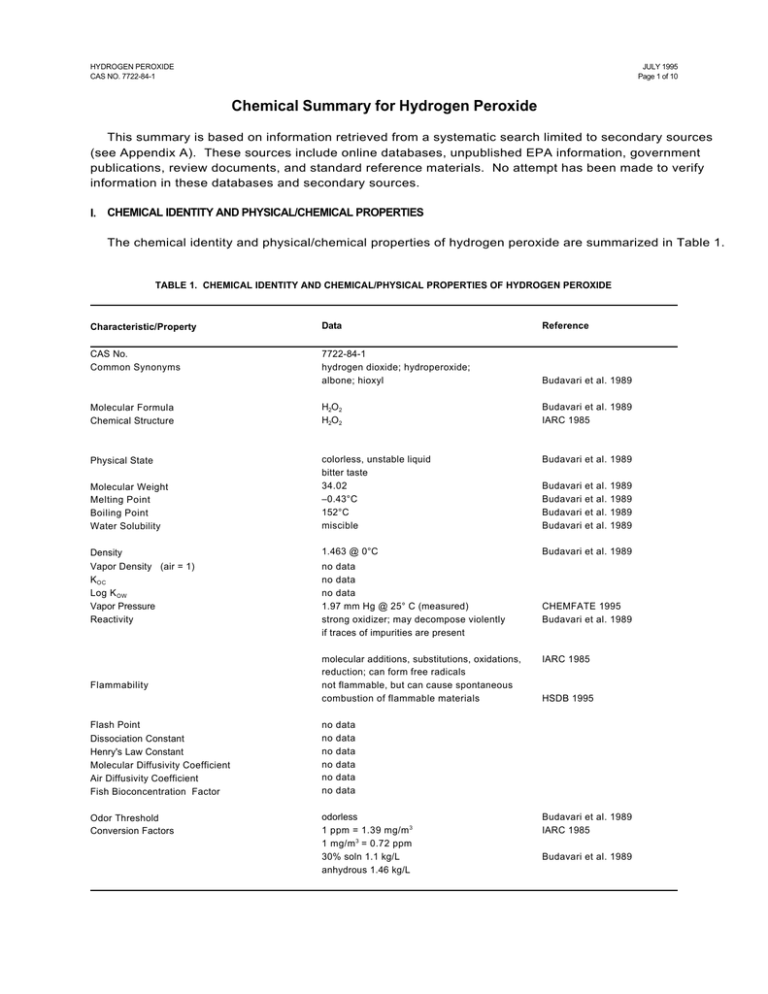
HYDROGEN PEROXIDE CAS NO. 7722-84-1 JULY 1995 Page 1 of 10 Chemical Summary for Hydrogen Peroxide This summary is based on information retrieved from a systematic search limited to secondary sources (see Appendix A). These sources include online databases, unpublished EPA information, government publications, review documents, and standard reference materials. No attempt has been made to verify information in these databases and secondary sources. I. CHEMICAL IDENTITY AND PHYSICAL/CHEMICAL PROPERTIES The chemical identity and physical/chemical properties of hydrogen peroxide are summarized in Table 1. TABLE 1. CHEMICAL IDENTITY AND CHEMICAL/PHYSICAL PROPERTIES OF HYDROGEN PEROXIDE Characteristic/Property Data Reference CAS No. Common Synonyms 7722-84-1 hydrogen dioxide; hydroperoxide; albone; hioxyl Budavari et al. 1989 Molecular Formula Chemical Structure H2O2 H2O2 Budavari et al. 1989 IARC 1985 Physical State colorless, unstable liquid bitter taste 34.02 –0.43°C 152°C miscible Budavari et al. 1989 1.463 @ 0°C Budavari et al. 1989 Molecular Weight Melting Point Boiling Point Water Solubility Density Vapor Density (air = 1) K OC Log K OW Vapor Pressure Reactivity Flammability no data no data no data 1.97 mm Hg @ 25° C (measured) strong oxidizer; may decompose violently if traces of impurities are present molecular additions, substitutions, oxidations, reduction; can form free radicals not flammable, but can cause spontaneous combustion of flammable materials Flash Point Dissociation Constant Henry's Law Constant Molecular Diffusivity Coefficient Air Diffusivity Coefficient Fish Bioconcentration Factor no no no no no no Odor Threshold Conversion Factors odorless 1 ppm = 1.39 mg/m 3 1 mg/m 3 = 0.72 ppm 30% soln 1.1 kg/L anhydrous 1.46 kg/L Budavari Budavari Budavari Budavari et et et et al. al. al. al. 1989 1989 1989 1989 CHEMFATE 1995 Budavari et al. 1989 IARC 1985 HSDB 1995 data data data data data data Budavari et al. 1989 IARC 1985 Budavari et al. 1989 HYDROGEN PEROXIDE CAS NO. 7722-84-1 II. JULY 1995 Page 2 of 10 ENVIRONMENTAL FATE A. Environmental Release No information was found in the secondary sources searched regarding the environmental release of hydrogen peroxide. Solutions of hydrogen peroxide gradually deteriorate (Budavari et al. 1989). Hydrogen peroxide is a naturally occurring substance. Gaseous hydrogen peroxide is recognized to be a key component and product of the earth’s lower atmospheric photochemical reactions, in both clean and polluted atmospheres. Atmospheric hydrogen peroxide is also believed to be generated by gas-phase photochemical reactions in the remote troposphere (IARC 1985) B. Transport No information was found in the secondary sources searched regarding the transport of hydrogen peroxide. C. Transformation/Persistence 1. Air — Hydrogen peroxide may be removed from the atmosphere by photolysis giving rise to hydroxyl radicals, by reaction with hydroxyl radicals, or by heterogenous loss processes such as rain-out (IARC 1985). 2. Soil — No information was found in the secondary sources searched regarding the transformation or persistence of hydrogen peroxide in soil, however, solutions of hydrogen peroxide gradually deteriorate (Budavari et al. 1989). 3. Water — Hydrogen peroxide is a naturally occurring substance. Surface water concentrations of hydrogen peroxide have been found to vary between 51-231 mg/L, increasing both with exposure to sunlight and the presence of dissolved organic matter (IARC 1985). 4. Biota — Hydrogen peroxide is a naturally occurring substance. Endogenous hydrogen peroxide has been found in plant tissues at the following levels (mg/kg frozen weight): potato tubers, 7.6; green tomatoes, 3.5; red tomatoes, 3.5; and castor beans in water, 4.7 (IARC 1985). III. HUMAN HEALTH EFFECTS A. Pharmacokinetics Hydrogen peroxide is a normal product of metabolism. It is readily decomposed by catalase in normal cells. In experimental animals exposed to hydrogen peroxide, target organs affected include the lungs, intestine, thymus, liver, and kidney, suggesting its distribution to those sites. Hydrogen peroxide has been detected in breath. 1. Absorption — Hydrogen peroxide is decomposed in the bowel before absorption (IARC 1985). When applied to tissue, solutions of hydrogen peroxide have poor penetrability (HSDB 1995). 2. Distribution — Hydrogen peroxide is produced metabolically in intact cells and tissues. It is formed by reduction of oxygen either directly in a two-electron transfer reaction, often catalyzed by flavoproteins, or by an initial one-electron step to O2 followed by dismutation to hydrogen peroxide (IARC 1985). Hydrogen peroxide has been detected in serum and in intact liver (IARC 1985). HYDROGEN PEROXIDE CAS NO. 7722-84-1 JULY 1995 Page 3 of 10 No specific information was found in the secondary sources searched concerning the distribution of hydrogen peroxide to which humans or animals have been exposed. However, based on the results of toxicity studies, the lungs, intestine, thymus, liver, and kidney may be distribution sites. In rabbits and cats that died after intravenous administration of hydrogen peroxide, the lungs were pale and emphysematous (IARC 1985). Following intraperitoneal injection of hydrogen peroxide in mice, pyknotic nuclei were induced in the intestine and thymus (IARC 1985). Degeneration of hepatic and renal tubular epithelial tissue was observed following oral administration of hydrogen peroxide to mice (IARC 1985). B. 3. Metabolism — Glutathione peroxidase, responsible for decomposing hydrogen peroxide, is present in normal human tissues (IARC 1985). When hydrogen peroxide comes in contact with catalase, an enzyme found in blood and most tissues, it rapidly decomposes into oxygen and water (HSDB 1995). 4. Excretion — Hydrogen peroxide has been detected in human breath at levels ranging from 1.0±0.5 :g/L to 0.34±0.17 :g/L (IARC 1985). Acute Toxicity Ingestion of large amounts of hydrogen peroxide causes chest and stomach pain, loss of consciousness, and motor disorders in humans and has caused mortality in experimental animals. Inhalation of high concentrations of vapor or mist causes irritation of nose and throat in humans. In appropriate solution, hydrogen peroxide is used in topical and dental gels. 1. Humans — In five persons who accidentally drank about 50 mL of a 33% hydrogen peroxide solution, symptoms included stomach and chest pain, retention of breath, foaming at the mouth, and loss of consciousness. Later, motor and sensory disorders, fever, microhemorrhages and moderate leucocytosis were noted. All recovered completely within 23 weeks (IARC 1985). Inhalation of high concentrations of hydrogen peroxide vapor or mist may cause extreme irritation and inflammation of the nose and throat (ACGIH 1991). Cases of rupture of the colon, inflammation of the anus or rectum, and ulcerative colitis have been reported following hydrogen peroxide enemas (IARC 1985). A characteristic whitening of the skin occurs after topical application of hydrogen peroxide (130%), which is believed the result of avascularity of the skin produced by oxygen bubbles acting microembolically in the capillaries (IARC 1985). Hydrogen peroxide as a topical gel is used to cleanse minor wounds or minor gum inflammation (HSDB 1995). Hydrogen peroxide concentrate is caustic and should not be tasted undiluted (HSDB 1995). 2. Animals — The intravenous LD50 of hydrogen peroxide in rats was reported to be 21 mg/kg (IARC 1985). The following percutaneous LD50s have been determined: rabbit, 630 mg/kg; rat, 700 to >7500 mg/kg (IARC 1985). HYDROGEN PEROXIDE CAS NO. 7722-84-1 JULY 1995 Page 4 of 10 Rats receiving 2.5% hydrogen peroxide (equivalent to approximately 3.5 g/kg/day )1 in their drinking water died within 43 days (IARC 1985). (Further experimental details not supplied.) C. Subchronic/Chronic Effects Hydrogen peroxide as a human food additive is generally regarded as safe when used in certain limitations. In experimental animals, oral administration of hydrogen peroxide causes dental, liver, kidney, stomach, and intestinal damage. Inhalation exposure to hydrogen peroxide caused skin irritation and sneezing in dogs, and high mortality in mice. 1. Humans — Hydrogen peroxide added to food is affirmed to be generally regarded as safe (GRAS) by the U.S. FDA when used to treat certain foods in specified limitations [FDA 21 CFR 184.1366 (4/1/93) as cited in HSDB 1995]. Hydrogen peroxide may be used as a component of articles for use in packaging, handling, transporting, or holding food in accordance with prescribed conditions [FDA 21 CFR 175.105 (4/1/93) as cited in HSDB 1995]. 2. Animals — Dose-related growth retardation, induction of dental caries, and pathological changes in the periodontium were observed in young male rats receiving 1.5% hydrogen peroxide as their drinking fluid (equivalent to approximately 2.1 g/kg/day)2 for 8 weeks (IARC 1985). Effects observed in mice treated for 35 weeks with 0.15% hydrogen peroxide as their drinking fluid (equivalent to approximately 0.29 g/kg/day)3 included degeneration of hepatic and renal tubular epithelial tissues, necrosis, inflammation, irregularities of tissue structure of the stomach wall, and hypertrophy of the small intestine wall. Concentrations in excess of 1% (equivalent to approximately 1.9 g/kg/day)4 resulted in pronounced weight loss and death within two weeks (IARC 1985). In a sequential study of mice treated with 0.4% hydrogen peroxide in drinking water (equivalent to approximately 0.76 g/kg/day)5 , gastric erosion was observed at 30 days and was present consistently throughout the 108 week study period (IARC 1985). 1 Calculated assuming the drinking fluid to be a 2.5% solution of H2O 2 , and assuming 1L of an H2O 2 solution = 1kg, which is multiplied by the concentration, 2.5%, which is multiplied by 0.049 L (the standard daily intake for an adult rat), divided by 0.35, the assumed adult rat body weight, to obtain the dose in mg/kg/day (U.S. EPA 1985). 2 Calculated assuming 1L of an H2O 2 solution = 1kg, which is multiplied by the concentration, 1.5%, which is multiplied by 0.049 L (the standard daily intake for an adult rat), divided by 0.35, the assumed adult rat body weight, to obtain the dose in mg/kg/day (U.S. EPA 1985). 3 Calculated assuming 1L of an H2O 2 solution = 1kg, which is multiplied by the concentration, 0.15%, which is multiplied by 0.0057 L (the standard daily intake for an adult mouse), divided by 0.030, the assumed adult mouse body weight, to obtain the dose in mg/kg/day (U.S. EPA 1985). 4 Calculated assuming 1L of an H2O 2 solution = 1kg, which is multiplied by the concentration, 1%, which is multiplied by 0.0057 L (the standard daily intake for an adult mouse), divided by 0.030, the assumed adult mouse body weight, to obtain the dose in mg/kg/day (U.S. EPA 1985). 5 Calculated assuming the drinking fluid to be a 0.4% solution of H2O 2 , and assuming 1L of an H2O 2 solution = 1kg, which is multiplied by the concentration, 0.4%, which is multiplied by 0.0057 L (the standard daily intake for an adult mouse), divided by 0.030, the assumed adult mouse body weight, to obtain the dose in mg/kg/day (U.S. EPA 1985). HYDROGEN PEROXIDE CAS NO. 7722-84-1 JULY 1995 Page 5 of 10 Dogs exposed 6 hours/day, 5 days/week for 6 months at an average vapor concentration of 7 ppm (9.73 mg/m3 ) of 90% hydrogen peroxide, developed skin irritation, sneezing, lacrimation, and bleaching of the hair. Autopsy disclosed pulmonary irritation and greatly thickened skin, but no hair follicle destruction. No significant changes in blood or urinary parameters were observed (ACGIH 1991). Following eight 6-hour exposures to hydrogen peroxide at a concentration of 79 mg/m3 (56.88 ppm), 7/9 mice died (U.S. EPA 1988). Following exposure to hydrogen peroxide at 93 mg/m3 , 6 hours/day, 5 days/week for 30 exposures, 1/10 rats died (U.S. EPA 1988). D. Carcinogenicity IARC has assigned an overall carcinogenicity rating of 3 to hydrogen peroxide: no data in humans, limited data in laboratory animals. Gastric and duodenal lesions including adenomas, carcinomas, and adenocarcinomas have been observed in mice treated orally with hydrogen peroxide. Marked strain differences in the incidence of tumors have been observed. Papilloma development has been observed in mice treated by dermal application. 1. Humans — No information regarding the carcinogenicity of hydrogen peroxide in humans was found in the secondary sources searched (IARC 1987). 2. Animals — IARC has assigned an overall carcinogenicity rating of 3 to hydrogen peroxide: limited data in laboratory animals (IARC 1987). Groups of 98, 101, and 99 C57BL/6J mice of both sexes were given 0, 0.1, and 0.4% hydrogen peroxide (a solution of 30% for food additive use) in distilled water (approximately 60-250 mg/kg/day)6 as drinking water for 100 weeks. Tumors observed were as follows: control, 1 duodenal adenoma; 0.1%, 6 adenomas, 1 carcinoma of the duodenum; 0.4%, 2 adenomas, 5 carcinomas of the duodenum (p <0.05). Survival data were not given (IARC 1985). Another group of 138 male and female C57BL/6N mice were treated with 0.4% hydrogen peroxide (a solution of 30% for food additive use) in distilled water (approximately 250 mg/kg/day)6 as drinking water, for up to 700 days with intermediate sequential groups sacrificed. ‘Nodules’ (hyperplastic lesions, adenomas and carcinomas) were found in the duodenum and stomach from 90 days until the end of the experiment. The lesions did not appear to increase in frequency over time, but atypical hyperplasia appeared late and 5% of the animals developed duodenal adenocarcinoma. No such lesions appeared in the controls (IARC 1985) In other experiments, marked strain differences were observed in the development of gastric and duodenal ‘nodules’ in mice treated with 0.4% hydrogen peroxide (a solution of 30% for food additive use) in distilled water (approximately 250 mg/kg/day)6 as drinking water for 90 to 210 days (IARC 1985). There was an inverse relationship between the incidence of duodenal ‘nodules’ (hyperplastic lesions, adenomas, carcinomas) and level of duodenal mucosa catalase activity in mice treated for 210 days with 0.4% hydrogen peroxide (approximately 250 mg/kg/day)6 in drinking water. Strains tested were: C3H/HeN, B6C3F1, C57BL/6N and C3H/Cb/s, with the following 6 1L of a 30% H2O 2 solution = 1.1 kg (Budavari et al 1989), which is multiplied by the concentration 30%, which is multiplied by the concentration, 0.1 or 0.4%, which is multiplied by 0.0057 L (the standard daily intake for an adult mouse), divided by 0.030, the assumed adult mouse body weight, to obtain the dose in mg/kg/day (U.S. EPA 1985). HYDROGEN PEROXIDE CAS NO. 7722-84-1 JULY 1995 Page 6 of 10 catalase activities: 5.3, 1.7, 0.7, and 0.4 x 10–4 k/mg protein, respectively. ‘Nodule’ incidences were 2/18, 7/22, 21/21, and 22/24 (IARC 1985). Mice received twice weekly topical applications of 30% hydrogen peroxide diluted 1:1 in 0.2 mL acetone for 25 weeks; 3/57 had papillomas at that time. No squamous-cell carcinoma was found when animals were observed up to 50 weeks (IARC 1985). E. Genotoxicity Hydrogen peroxide induced DNA damage, sister chromatid exchanges and chromosomal aberrations in mammalian cells in vitro (IARC 1985). Hydrogen peroxide induced DNA damage in bacteria (Escheria coli), and was mutagenic to bacteria (Salmonella typhimurium) and the fungi, Neurospora crassa and Aspergillis chevallieri, but not to Streptomyces griseoflavus. It was not mutagenic to Drosophila melanogaster or to mammalian cells in vitro. F. Developmental Toxicity No information regarding the developmental toxicity of hydrogen peroxide to humans was found in the secondary sources searched. Malformations have been observed in chicken embryos treated with hydrogen peroxide, but experiments with mice and rats have been negative. 1. Humans — No information regarding the developmental toxicity of hydrogen peroxide to humans was found in the secondary sources searched. 2. Animals — Female rats that received 0.45% hydrogen peroxide (equivalent to approximately 630 mg/kg/day)7 as the sole drinking fluid for five weeks produced normal litters when mated with untreated males (IARC 1985). Doses of 1.4 to 11 :mol/egg hydrogen peroxide (purity 30%) dissolved in water were injected into the airspace of groups of 20-30 white leghorn chicken eggs on day 3 of incubation. Embryos were examined on day 14. The incidence of embryonic deaths and malformations was dose-related and detected at doses of 2.8 :mol/egg and above. The combined ED50 was 2.7 :mol/egg (IARC 1985). G. Reproductive Toxicity No information regarding the reproductive toxicity of hydrogen peroxide to humans was found in the secondary sources searched. No evidence of reproductive toxicity was seen in one experiment in mice. 1. 7 Humans — No information regarding the reproductive toxicity of hydrogen peroxide to humans was found in the secondary sources searched. Calculated assuming the drinking fluid to be a 0.45% solution of H2O 2 , and assuming 1L of an H2O 2 solution = 1kg, which is multiplied by the concentration, 0.45%, which is multiplied by 0.049 L (the standard daily intake for an adult rat), divided by 0.35, the assumed adult rat body weight, to obtain the dose in mg/kg/day (U.S. EPA 1985). HYDROGEN PEROXIDE CAS NO. 7722-84-1 2. H. JULY 1995 Page 7 of 10 Animals — A 1% solution of hydrogen peroxide (equivalent to 1900 mg/kg/day)8 given as the sole drinking fluid to three-month-old male mice for 7-28 days did not cause infertility (IARC 1985). Neurotoxicity Large amounts of hydrogen peroxide taken orally by humans has caused apnea, dizziness, headache, weakness in the extremities, convulsions, loss of consciousness and shock. No information regarding the neurotoxicity of hydrogen peroxide to animals was found in the secondary sources searched. 1. Humans — Five persons who accidentally drank about 50 mL of 33% hydrogen peroxide solution lost consciousness, and later developed motor and sensory disorders. All recovered completely within 2-3 weeks (IARC 1985). A 33 year old woman who accidentally drank one pint of 35% hydrogen peroxide became apneic and dependent on mechanical ventilation; recurrent seizures were controlled with phenytoin. Bilateral cerebral hemisphere swelling was determined. Neurologic examination demonstrated patchy areas of weakness in the extremities, truncal ataxia and inability to maintain a sitting position (HSDB 1995). Severe systemic poisoning may cause headache, dizziness, tremors, numbness, convulsions, unconsciousness, and shock (ACGIH 1991). 2. Animals — No information regarding the neurotoxicity of hydrogen peroxide to animals was found in the secondary sources searched. IV. ENVIRONMENTAL EFFECTS Hydrogen peroxide is a naturally occurring substance which is produced metabolically and atmospherically. In the atmosphere, it is produced photochemically and reacts with hydrocarbons. Hydrogen peroxide is of low to moderate acute toxicity to aquatic organisms. No information regarding the toxicity of hydrogen peroxide to terrestrial organisms was located in the secondary sources searched. A. Toxicity to Aquatic Organisms A 24-hour LC50 of 89,000 µg/L (89 mg/L) hydrogen peroxide was determined for the mackerel, Trachurus japonicus, and a 24-hour LC50 of 155,000 µg/L (155 mg/L) hydrogen peroxide was determined for the chameleon gobi, Tridentiger trigonocephalus (AQUIRE 1995). 8 Calculated assuming the drinking fluid to be a 1% solution of H2O 2 , and assuming 1L of an H2O 2 solution = 1kg, which is multiplied by the concentration, 1%, which is multiplied by 0.0057 L (the standard daily intake for an adult mouse) divided by 0.030, the assumed adult mouse body weight, to obtain the dose in mg/kg/day (U.S. EPA 1985). HYDROGEN PEROXIDE CAS NO. 7722-84-1 JULY 1995 Page 8 of 10 A 28-hour LT50 9 of 30,000 µg/L (30 mg/L), and a 228-hour LT50 of 12,000 µg/L (12 mg/L) hydrogen peroxide, were determined for the zebra mussel, Dreissena polymorpha (AQUIRE 1995). B. Toxicity to Terrestrial Organisms No information regarding the toxicity of hydrogen peroxide to terrestrial organisms was found in the secondary sources searched. C. Abiotic Effects Gaseous hydrogen peroxide is recognized to be a key component and product of the earth’s lower atmospheric photochemical reactions, both in clean and polluted atmospheres. Significantly higher hydrogen peroxide concentrations are found in polluted atmospheres as compared with clean air. These concentrations are believed to arise from photochemically–-initiated oxidation of reactive hydrocarbons (IARC 1985). Under severe smog conditions, daytime levels of hydrogen peroxide as high as 0.18 ppm have been reported, but atmospheric night-time levels of 2-5 ppb did not correlate to smog intensity (IARC 1985). V. EPA/OTHER FEDERAL/OTHER GROUP ACTIVITY Agencies that have set regulatory standards for hydrogen peroxide are listed in Tables 2 and 3. TABLE 2. EPA OFFICES AND CONTACT NUMBERS FOR INFORMATION ON HYDROGEN PEROXIDE EPA Office Statute Contact Number Pesticides FIFRAa (active ingredient) (800) 858-7378 Solid Waste & Emergency Response CERCLAb (SARA 302A) (800) 535-0202 a FIFRA: Federal Insecticide, Fungicide, and Rodenticide Act b CERCLA: Comprehensive Environmental Response, Compensation, and Liability Act of 1980, as amended. 9 Lethal Time 50 = time required for 50% of animals to die at a preselected concentration. HYDROGEN PEROXIDE CAS NO. 7722-84-1 JULY 1995 Page 9 of 10 TABLE 3. OTHER FEDERAL OFFICES/OTHER GROUP CONTACT NUMBERS FOR INFORMATION ON HYDROGEN PEROXIDE Other Agency/Department/Other Group American Conference of Governmental Industrial Hygienists (Recommended Exposure Limita: 1 ppm [1.4 mg/m3]) Consumer Product Safety Commission Food & Drug Administrationb National Institute for Occupational Safety & Health (Recommended Exposure Limita: 1 ppm [1.4 mg/m3]; IDLH: 75 ppm) Occupational Safety & Health Administration (Permissible Exposure Limitc: 1 ppm [1.4 mg/m3]) Contact Number (513) 742-2020 (301) 504-0994 (301) 443-3170 (800) 356-4674 Check local phone book for phone number under Department of Labor a The ACGIH/NIOSH exposure limits are time-weighted average (TWA) concentrations for an 8-hour workday (ACGIH) and up to a 10-hour workday (NIOSH) during a 40-hour workweek. IDLH: immediate danger to life and health. (ACGIH 1994-1995) (NIOSH 1994) b Uses include as a food additive and as a topical wound dressing. c The OSHA exposure limit is a time-weighted average (TWA) concentration for an 8-hour workshift during a 40-hour workweek (OSHA 1993). HYDROGEN PEROXIDE CAS NO. 7722-84-1 VI. JULY 1995 Page 10 of 10 CITED REFERENCES ACGIH. 1994-1995. American Conference of Governmental Industrial Hygienists. Threshold Limit Values and Biological Exposure Indices. ACGIH, Cincinnati, OH, pp. 23. ACGIH. 1991. American Conference for Governmental Industrial Hygienists, Inc. TLVs®. Documentation of the Threshold Limit Values and Biological Exposure Indices, 6th ed. ACGIH, Cincinnati, OH., p. 782783. AQUIRE. 1995. Aquatic Information Retrieval online data base. Chemical Information Systems, Inc., a subsidiary of Fein-Marquart Assoc. (Retrieved 6/95). Budavari S, O'Neil MJ, Smith A, Heckelman PE (Eds.). 1989. The Merck Index, 11th ed. Merck & Co., Inc., Rahway, NJ, p. 760. CHEMFATE. 1995. Syracuse Research Corporation's Environmental Fate Data Bases. Syracuse Research Corporation, Syracuse, NY. Retrieved 2/95. HSDB. 1995. Hazardous Substances Data Bank. MEDLARS Online Information Retrieval System, National Library of Medicine. IARC. 1985. International Agency for Research on Cancer. Hydrogen Peroxide. In: IARC Monographs on the Evaluation of Carcinogenic Risk of Chemicals to Humans: Allyl Compounds, Aldehydes, Epoxides and Peroxides, Vol. 36. IARC, Lyon, pp. 285-314. IARC. 1987. International Agency for Research on Cancer. IARC Monographs on the Evaluation of Carcinogenic Risk of Chemicals to Man. Overall evaluations of carcinogenicity. An updating of Vols. 1 to 42. IARC, Lyon, p. 64. NIOSH. 1994. National Institute for Occupational Safety and Health. Pocket Guide to Chemical Hazards. NIOSH, U.S. Department of Health and Human Services, Cincinnati, OH, p. 168-169. OSHA. 1993. Occupational Safety and Health Administration. Table Z-1. Limits for Air Contaminants. Fed Reg 58:35343. U.S. EPA. 1988. U.S. Environmental Protection Agency. Reportable Quantity Document for Hydrogen Peroxide. Office of Solid Waste and Emergency Response, Environmental Criteria and Assessment Office, U.S. EPA, Cincinnati, OH, 9 p. U.S. EPA. 1985. U.S. Environmental Protection Agency. Reference Values for Risk Assessment. Environmental Criteria and Assessment Offices, U.S. EPA, Cincinnati, OH, Table 1-2. APPENDIX A. SOURCES SEARCHED FOR SUMMARY PREPARATION ACGIH. 1991. American Conference of Governmental Industrial Hygienists. Documentation of Threshold Limit Values and Biological Exposure Indices, 6th ed. ACGIH, Cincinnati, OH. ACGIH. 1994-1995. American Conference of Governmental Industrial Hygienists. Threshold Limit Values for Chemical Substances and Physical Agents and Biological Exposure Indices. ACGIH, Cincinnati, OH. AQUIRE. 1994. Aquatic Information Retrieval online data base. Chemical Information Systems, Inc., a subsidiary of Fein-Marquart Assoc. ATSDR. 1989-1994. Agency for Toxic Substances and Disease Registry. Toxicological Profiles. ATSDR, Chamblee, GA. Budavari S, O'Neil MJ, Smith A, Heckelman PE (Eds.). 1989. The Merck Index, 11th ed. Merck & Co., Inc., Rahway, NJ. CHEMFATE. 1995. Syracuse Research Corporation's Environmental Fate Data Bases. Syracuse Research Corporation, Syracuse, NY. Clayton GD, Clayton FE. 1981-1982. Patty's Industrial Hygiene and Toxicology, 3rd ed., Vol. 2C. John Wiley & Sons, New York. HSDB. 1994. Hazardous Substances Data Bank. MEDLARS Online Information Retrieval System, National Library of Medicine. IARC. 1979-1994. International Agency for Research on Cancer. IARC Monographs on the Evaluation of Carcinogenic Risk of Chemicals to Man. IARC, Lyon. NIOSH. 1992. National Institute for Occupational Safety and Health. NIOSH Recommendations for Occupational Safety and Health. Compendium of Policy Documents and Statements. NIOSH, Cincinnati, OH. NIOSH. 1994. National Institute for Occupational Safety and Health. NIOSH Pocket Guide to Chemical Hazards. NIOSH, Cincinnati, OH. NTP. 1994. National Toxicology Program. Toxicology and Carcinogenesis Studies. Tech Rep Ser. NTP. 1994. National Toxicology Program. Management Status Report. Produced from NTP Chemtrack system. April 8, 1994. National Toxicology Program, Research Triangle Park, NC. OSHA. 1994. Occupational Safety and Health Administration. Table Z-2. Limits for Air Contaminants. RTECS. 1994. Registry of Toxic Effects of Chemical Substances. MEDLARS Online Information Retrieval System, National Library of Medicine. TSCA. 1995. Toxic Substances Control Act. TSCATS data submissions. U.S. Air Force. 1989. The Installation Restoration Toxicology Guide, Vols. 1-5. Wright-Patterson Air Force Base, OH. U.S. EPA (U.S. Environmental Protection Agency). 1991. Table 302.4 List of Hazardous Substances and Reportable Quantities 40 CFR, part 302.4:3-271. U.S. EPA. Most current. Drinking Water Regulations and Health Advisories. Office of Drinking Water, U.S. Environmental Protection Agency, Washington, D.C. U.S. EPA. Most Current. Health Effects Assessment Summary Tables. Environmental Criteria and Assessment Office, U.S. EPA., Cincinnati, OH. U.S. EPA reviews such as Health and Environmental Effects Documents, Health and Environmental Effect Profiles, and Health and Environmental Assessments. U.S. EPA. 1994. Integrated Risk Information System (IRIS) Online. Cincinnati, OH: Office of Health and Environmental Assessment.



